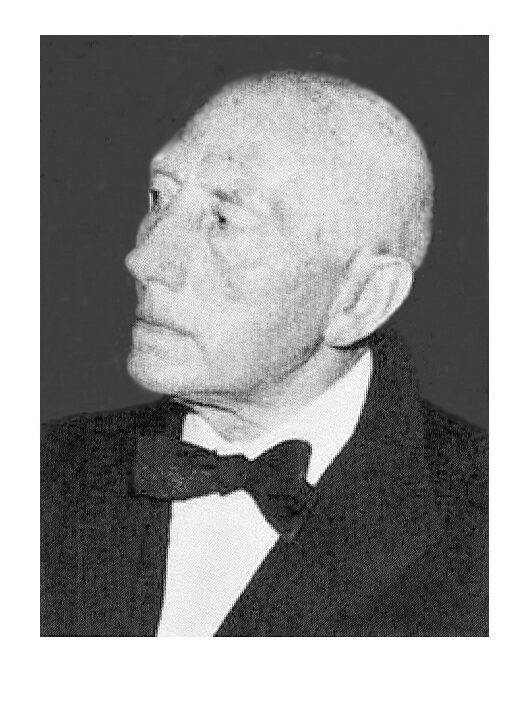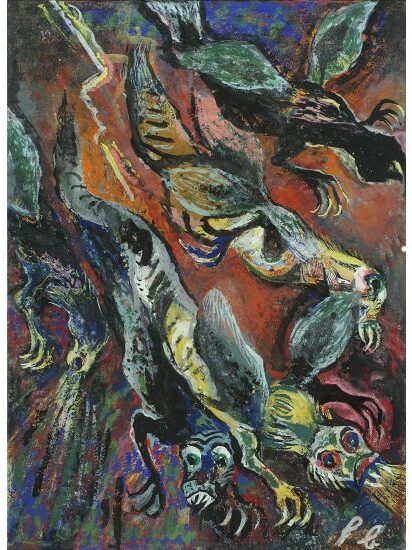Tree, Franz
Painter
Baum, Franz Maximilian
Born: January 14, 1888 in Wiesbaden
Died: May 6, 1982 in Tegernsee
Franz Baum was born into the third generation of the respected Baum family of manufacturers. He was the son of Hermann Baum senior (1850 - 1914), partner in the company Nassauische Leinenindustrie Joseph Maier Baum, and his wife Julia Anna, née Bloch (1859 - 1911), a concert pianist. He was also the younger brother of the art historian Julius Baum and cousin of the businessman Joseph Baum. Franz Baum attended the humanistic "Königliches Gymnasium zu Wiesbaden" at Luisenplatz (No. 10) and passed his school-leaving examination there in 1906.
Growing up in a wealthy and artistic family, he decided, like his brother Julius, not to join the family business and pursue a commercial career, but to follow his talent and pursue a career in art. From 1908 to 1910, he studied at the Academy of Fine Arts in Stuttgart, then from October 1911 to 1914 at the Academy of Fine Arts in Munich. Here Baum was a student of the German impressionist Heinrich von Zügel (1850 - 1941), a founding member of the "Verein bildender Künstler Münchens Secession e.V.", or Munich Secession for short.
As an officer and outstanding horseman, Baum took part in the First World War and was twice awarded the Iron Cross for bravery. Numerous war and equestrian studies were created during this time and were exhibited in Stuttgart in 1919, where Baum was recovering from serious war injuries. He met the anthroposophist Rudolf Steiner and maintained contacts with the newly founded Bauhaus. From 1920, he lived in Munich again and, as a member of the Munich Secession, took part in its exhibitions at the Glaspalast in Munich every year from 1920 to 1931, with only one exception in 1925, in the first few years with etchings and watercolor pen and ink drawings, and from 1923 with oil paintings. He also studied the painting technique of the old masters under Max Doerner (1870 - 1939) at the Academy of Fine Arts. Baum, who had lost his fortune due to inflation, taught dressage riding at a Munich riding school from 1924 to 1934, possibly even until 1937.
In 1934, he married the American art student Abby Spencer Beveridge (1910 - 1969), whom he had probably already met in 1931 while teaching at the Academy of Fine Arts. After Baum was excluded from the Reich Chamber of Culture in 1936 due to his Jewish origins, the couple retired to the artists' village of Polling in Upper Bavaria. Here, in 1936, he created three surviving frescoes with a Christian theme, a St. George and two depictions of part of the legend of the foundation of the monastery, the latter copies of two late Gothic panels from the former altar of the cross in the collegiate church, on an outbuilding of the former Augustinian monastery.
Baum left Germany in mid-February 1939 and emigrated to the USA. His wife and son (*1937) followed him two months later. Thanks to her American citizenship, his wife was able to save the works Baum had been forced to leave behind in his studio from being lost in the USA. The family initially settled in Seattle/Washington and moved from there in 1943, now with three children (*1939, *1941), to Santa Cruz/California, where Baum acquired a large estate in the Santa Cruz Mountains. He became a member of the San Francisco Art Association and went on to exhibit widely, including at the Museum of Modern Art/San Francisco, the Seattle Art Museum and the Institute of Contemporary Art/Boston. He gave private lessons and courses for adults organized by Stanford University. After his divorce in 1954, Baum returned to Munich in 1958 at the age of seventy and exhibited regularly at the Haus der Kunst in the following years. In 1963 he moved to Tegernsee, where he died in 1982. In 1988, the town of Tegernsee organized a memorial exhibition on the occasion of his 100th birthday, which showed the honoured artist as a level-headed, spiritual artist.
Baum, who worked as an artist, exhibited and taught well into old age, is one of the artists of the so-called "lost generation". As can be seen from his few works, most of which are only available as illustrations, he developed his own unique, expressive and fantastical style, which was very much in line with "classical modernism". His paintings preferably show landscapes, details of nature, mythical creatures, apocalyptic visions as well as the animal and circus world, especially horses. According to family tradition, Eastern philosophy and the rites of the Catholic Church as well as the ideas of Rudolf Steiner were also significant for Baum's life and work.
In 1965/66, three of his colored brush drawings were on display in Wiesbaden as part of an exhibition organized by the Nassauischer Kunstverein e.V. (Graphic Exhibition of Wiesbaden Artists: Commemorative Exhibition on the 100th Birthday of Hans Völcker). Unfortunately, an exhibition of larger works in his native city of Wiesbaden, which Baum had requested, did not materialize. He was last honored in 2007/08 in an exhibition at the Kallmann Museum in Ismaning. His works are in public and private collections and his estate is owned by his family.
The text was edited by author Mechthild Maisant in May 2021.
Literature
- Flyer zur Ausstellung im Kallmann-Museum Ismaning
Rediscovered: Franz Baum, Heinrich Heidner, Rudolf Möller. 23.11.2007 - 10.2.2008.
- Von der Dollen, Ingrid; Zimmermann, Rainer; Finckh, Gerhard
The Joseph Hierling Collection. Expressive Realism. Schweinfurter Museumsschriften Volume 166, Erich Schneider (ed.), Schweinfurt 2009 (p. 31).
- Trier, Dankmar
Baum, Franz (1888). In: AKL Online (Allgemeines Künstlerlexikon), Berlin, New York, Dok-ID:_10109914 (retrieved 6/2011).

